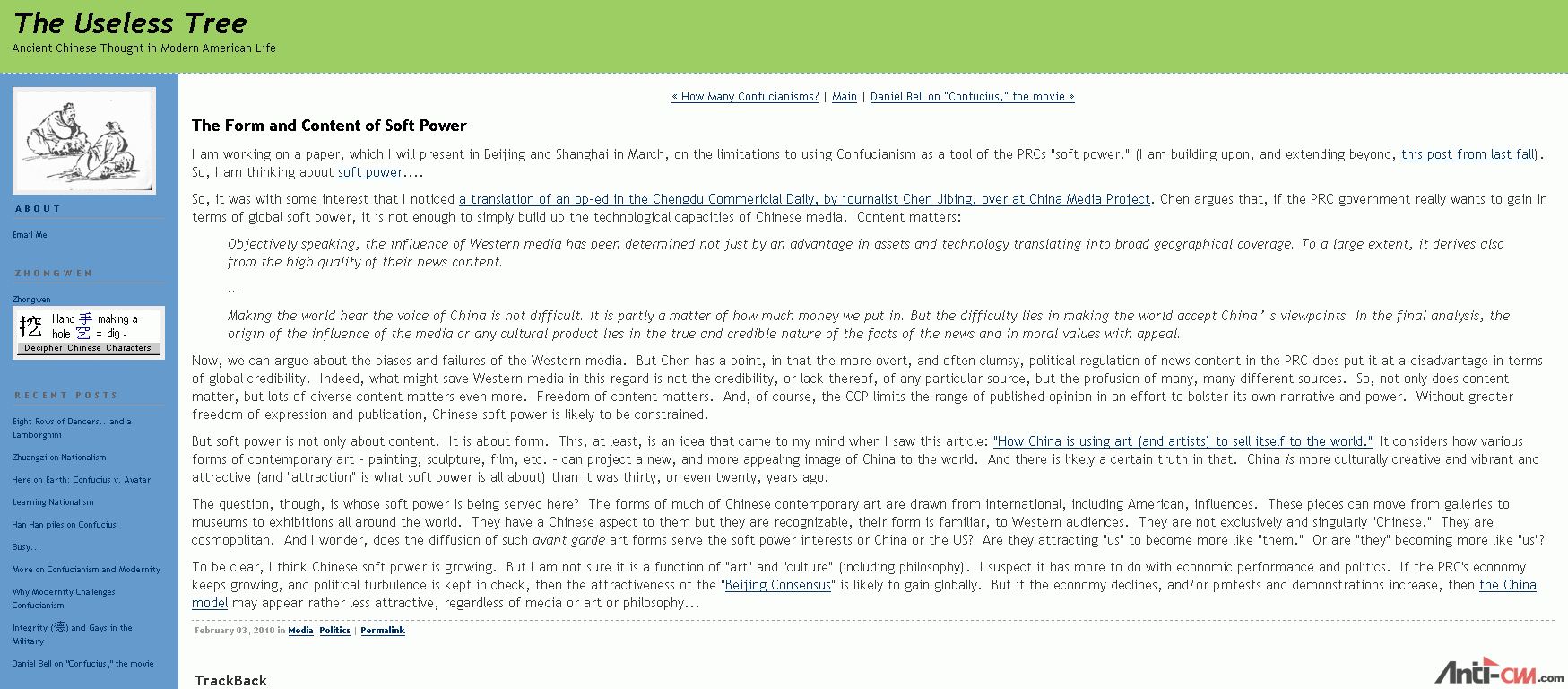|
|
【原文链接】http://uselesstree.typepad.com/useless_tree/2010/02/the-form-and-content-of-soft-power.html
I am working on a paper, which I will present in Beijing and Shanghai in March, on the limitations to using Confucianism as a tool of the PRCs "soft power." (I am building upon, and extending beyond, this post from last fall). So, I am thinking about soft power....
So, it was with some interest that I noticed a translation of an op-ed in the Chengdu Commericlal Daily, by journalist Chen Jibing, over at China Media Project. Chen argues that, if the PRC government really wants to gain in terms of global soft power, it is not enough to simply build up the technological capacities of Chinese media. Content matters:
Objectively speaking, the influence of Western media has been determined not just by an advantage in assets and technology translating into broad geographical coverage. To a large extent, it derives also from the high quality of their news content.
...
Making the world hear the voice of China is not difficult. It is partly a matter of how much money we put in. But the difficulty lies in making the world accept China’s viewpoints. In the final analysis, the origin of the influence of the media or any cultural product lies in the true and credible nature of the facts of the news and in moral values with appeal.
Now, we can argue about the biases and failures of the Western media. But Chen has a point, in that the more overt, and often clumsy, political regulation of news content in the PRC does put it at a disadvantage in terms of global credibility. Indeed, what might save Western media in this regard is not the credibility, or lack thereof, of any particular source, but the profusion of many, many different sources. So, not only does content matter, but lots of diverse content matters even more.
Freedom of content matters. And, of course, the CCP limits the range of published opinion in an effort to bolster its own narrative and power. Without greater freedom of expression and publication, Chinese soft power is likely to be constrained.
But soft power is not only about content. It is about form. This, at least, is an idea that came to my mind when I saw this article: "How China is using art (and artists) to sell itself to the world." It considers how various forms of contemporary art - painting, sculpture, film, etc. - can project a new, and more appealing image of China to the world. And there is likely a certain truth in that. China is more culturally creative and vibrant and attractive (and "attraction" is what soft power is all about) than it was thirty, or even twenty, years ago.
The question, though, is whose soft power is being served here? The forms of much of Chinese contemporary art are drawn from international, including American, influences. These pieces can move from galleries to museums to exhibitions all around the world. They have a Chinese aspect to them but they are recognizable, their form is familiar, to Western audiences. They are not exclusively and singularly "Chinese." They are cosmopolitan. And I wonder, does the diffusion of such avant garde art forms serve the soft power interests or China or the US? Are they attracting "us" to become more like "them." Or are "they" becoming more like "us"?
To be clear, I think Chinese soft power is growing. But I am not sure it is a function of "art" and "culture" (including philosophy). I suspect it has more to do with economic performance and politics. If the PRC's economy keeps growing, and political turbulence is kept in check, then the attractiveness of the "Beijing Consensus" is likely to gain globally. But if the economy declines, and/or protests and demonstrations increase, then the China model may appear rather less attractive, regardless of media or art or philosophy...

|
content, Form, Power, soft, The, content, Form, Power, soft, The, content, Form, Power, soft, The
评分
-
1
查看全部评分
-
|